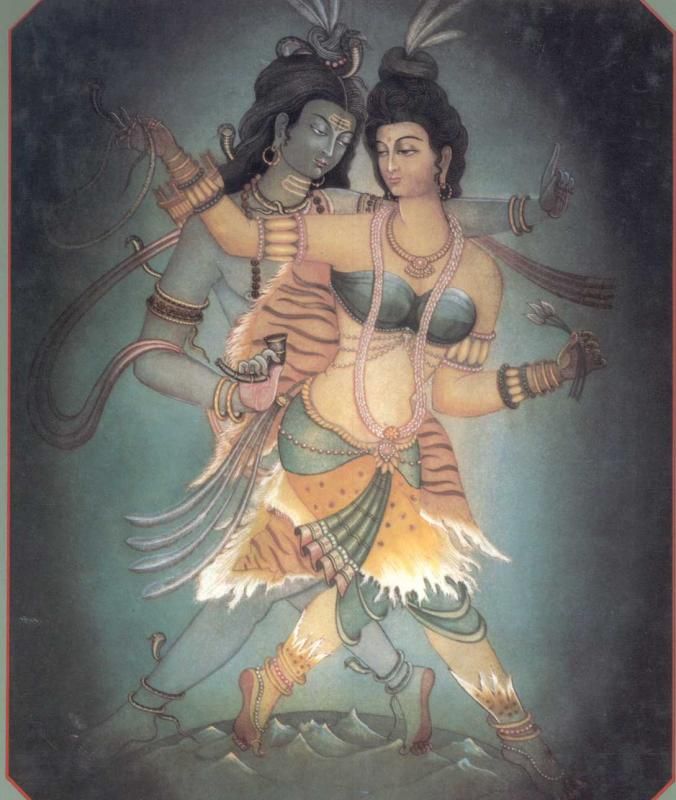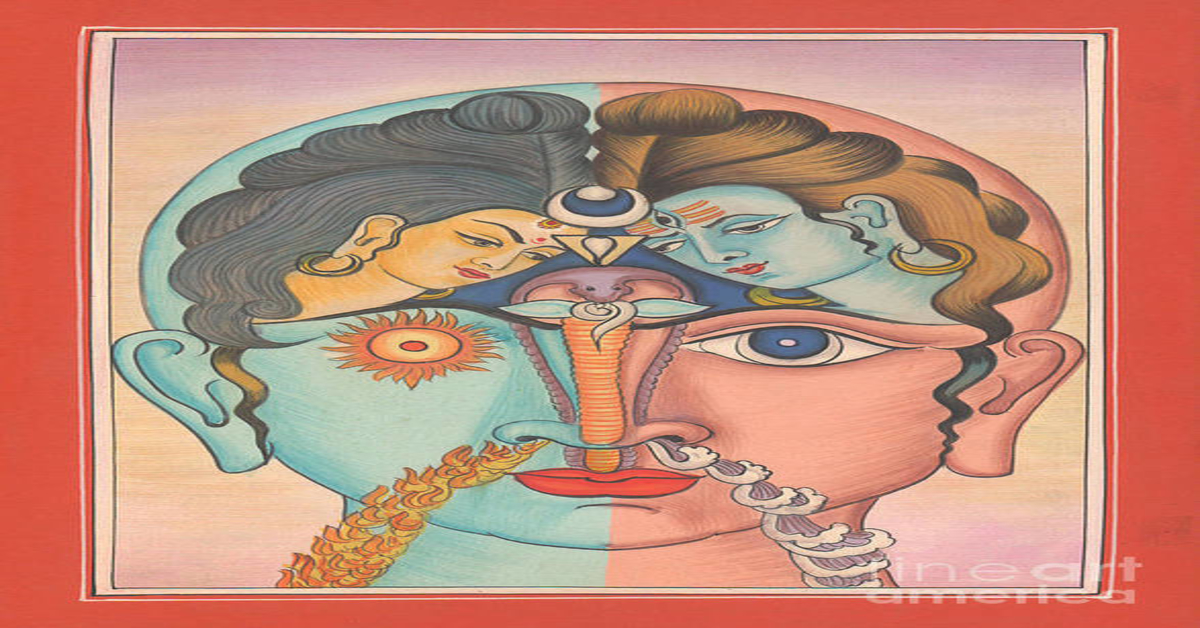According to Tantra, Shiva represents the formless, unmanifested, cosmic consciousness. Whereas, Shakti represents formed, manifested, energy. Shakti is the energy not only restricted to the cosmos but also present in each and every individual. Just like Shiva is the supreme consciousness pervading each individual and the whole cosmos. Union of Shiva and Shakti is the way to know reality.
Shakti is considered as the power that manifests the potential contained in the consciousness. It is responsible for creating the varied forms manifested in the universe, i.e., she is the creator of man, objects, things, planets, trees, etc. Shiva that from which she creates.
It is said that through Shakti Shiva can experience himself.
Shiva is the principle of changelessness, and Shakti is the principle for change. Although, in Tantric philosophy, there is a contradiction or paradox at play. Even though both Shiva and Shakti have been given different attributes, they are still considered the same. The changeable and the changelessness are the same, understanding this is the perfect union, the dissolution of duality. The aim of tantra and yoga is the dissolution of duality.
This indifference between energy and consciousness, Shiva and Shakti, is realized at higher states of awareness. When a person has advanced ahead in his yoga or tantra sadhana.

Role of Tantra in Realization
The goal of Tantra is to retrace the path from the manifestation (Shakti) to the source (Shiva).
Shakti is used as the vehicle to reunite the individual with the supreme experience that is samadhi, nirvana and the various other names for attaining unity across traditions. The goal of tantra is to lead you, the individual or the jiva, to the patam atman or the supreme.
Maya
For Tantra, the power of manifestation (shakti) is in its true essence consciousness itself. But it is hidden from us because of the phenomenal world we live in, the world that creates this illusion (Maya). It is not in ordinary state of awareness that we can understand this union between Shiva and Shakti.
According to Tantra, it is difficult to comprehend that each thing existing in this universe is nothing but manifested consciousness.
The consciousness itself, i.e., Shiva does not change in its nature or content even though everything comes from it. It is said so in Ishavasay Upanshisad about the nature of this supreme consciousness:
That is full, this is full.
From full, the full is taken,
the full has come.
If you take out the full from the full,
the full alone remains.
Shiva is the source of the universe; from Shiva, the universe comes but everything individually comes through the power of Shakti.
Yet in the highest sense, when the realization comes through Tantra and Yoga, the union of Shiva and Shakti occurs, they are understood to be one and the same. This is a big paradox, a conflict, a mystery that is resolved by Sages and Siddhas through experience and is difficult to articulate in mere words.
Tantra vs Non-Duality
Unlike other philosophical systems like Advaita, Tantra believes that both the manifested world and the unmanifested world are real. The film and the screen, the background, and the projection are real. The experienced world (the world of senses) and the higher world (experienced at higher levels of awareness) both are real.
The body, mind, symbols, and rituals are to be used to know that which is beyond. In a way, it saves from the sense of disillusionment and existentialism that might take place if the world around us, visible to use and experienced by us is denied.
Shiva
According to Tantra, Shiva is the pita (father) of all that is stationary or moving. He is considered a Digambar (clothed in the air). He mostly wears a tiger skin and holds a trident that represents three qualities of nature:
- tamas (inertia and darkness),
- rajas (activity)
- sattwa (light and harmony)
His vehicle for transport is a bull called Nandi. The supreme consciousness of Shiva is usually symbolized by the Shiva lingam. Shiva is believed to be unconditioned or uninfluenced by the rules and norms of society. He is said to exist constantly in the state of nirvikalpa samadhi (second-highest state of samadhi according to Patanjali’s Yogasutra).
In the yogic tradition, he is called Adiyogi (the first yogi) and Yogeshwara (the king of all yogis).
In the tantric tradition, he is known as Kuleshana, the lord of the Kaulas (a religious tradition in Tantric Shaktism and Shaivism).
Shakti
Shakti is associated with numerous names, concepts, and aspects across the Tantric tradition. A few of these are:
- Prana – the vital energy responsible for growth and arrangement of all life forms
- Kali – the dissolver of the world, one who withdraws into her womb things at the end of their allotted life span
- Kundalini – the power lying dormant in the base of the spine that can be unleashed through tantric practices
- Parvati – the faithful and loving wife of Shiva
- Adhyashakti – the primordial power
- Ishwari – the lord of the universe
- Avidya Rupini – a form responsible for ignorance of an individual of the reality or true form of everything (supreme consciousness or brahman)
- Vidya Rupini – a form of knowledge, because it is her world of senses and objects that one can use to know the ultimate reality (using the body for meditation and yoga to attain enlightenment)
She is also recognized as Maya – the creator of illusions – for it is her world of differentiated forms because of which one fails to realize the unity. At the same time, she is Shakti the energy that allows us to experience the world, move our minds and body and practice tantra and yoga. She is the key to reaching Shiva.

Union of Shiva and Shakti
Shakti (energy) when united with Shiva (cosmic consciousness) is called Parabhrahman, the absolute. Energy can be nurtured and guided by consciousness but consciousness itself can’t express itself without energy.
Adi Shankara asks in Saundarya Lahari (a prominent tantric textbook): “How can Shiva function without Shakti?”
Therefore, in Tantra, Shakti is an indispensable means to merge with consciousness, to reach Shiva. A supreme, divine experience takes place with the union of Shiva and Shakti. Some say it is the realization of Brahman, others “not this, not this” to show that it is inexpressible.
It can be expressed as the state of nirvana, samadhi, or perfect oneness.
This state is often depicted symbolically as Shiva and Shakti embracing each other tightly, such that they cease to become separate. This is the divine embrace.
References
- Book: History of the Tantric Religion An Historical, Ritualistic, and Philosophical Study, 2006 by N. N. Bhattacharyya
- Book: A Systematic Course in the Ancient Tantric Techniques of Yoga and Kriya by Swami Satyananda Saraswati
- Boook: Tantra Illuminated: The Philosophy, History, and Practice of a Timeless Tradition by Christopher D. Wallis
- Book: Isha Upanishad

that some deep insight.